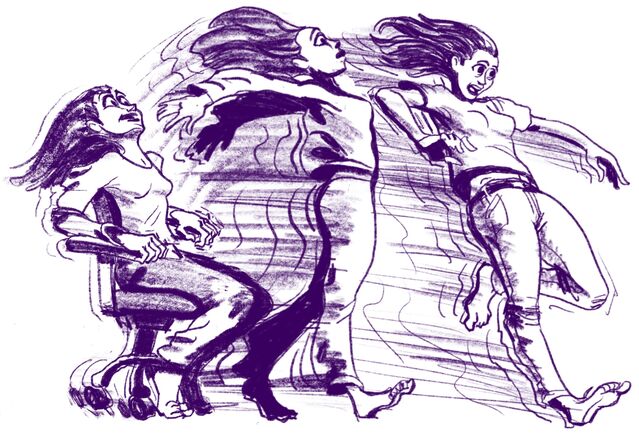Fear
Uncovering the Mystery of Tachysensia
What is it like to experience symptoms of tachysensia?
Posted September 23, 2021 Reviewed by Chloe Williams
Key points
- Tachysensia is a condition that can temporarily alter sensations of time and sound in troubling ways for people who experience symptoms.
- The cause of tachysensia is unknown but there are certain conditions in which symptoms can manifest, such as migraines and epilepsy.
- Tachysensia can occur at any age but it is more common in childhood and adolescence. Many people outgrow the condition.

By Joseph Mazur and Osman Farooq
Several of my past Psychology Today posts generated a mammoth wealth of stories involving mystery symptoms of what lately has been called tachysensia syndromes.
Under my naïve neurological understanding guided by consultations with psychiatrists and neurologists, I replied to everyone individually. I cautiously wrote that with billions of neuronal connections firing 24 hours a day, an occasional short-circuited moment is likely to happen when the brain memory of its developmental experiences of circadian time misfires because of a blip of electro- or biochemical interference. Those occasional interferences often accommodate strange mind-changing inhibitors producing fear, awe, stress, and changes in body temperature.
We might ask why those blips happen. On the other hand, it is a wonder why they do not. The brain is a phenomenal organ. Considering the billions of neurons that could misfire their electronic signals through the network, the brain miraculously follows a complex synchronization between what it expects of the world and what the body needs to stay healthy. Perhaps a few moments of speed-sense misfirings should be celebrated as glorious moments that could be reminders that we are humans who can perceive times that do not align with familiarity.
But who am I to say these things. Let me welcome an expert neurologist researching the tachysensia experience. Osman Farooq is a clinical associate professor of neurology at the Jacobs School of Medicine and Biomedical Sciences, University of Buffalo, my guest author for this post. He specializes in child neurology, epilepsy, neuromuscular disorders, and pediatrics. After several months of collecting reader accounts of episodes, Dr. Farooq is here to give his professional opinion.
First, here are a few brief excerpts of reader accounts of the most vivid descriptions of tachysensia symptoms.
The first comes from Dusty Mitchell, a 32-year-old woman experiencing one or two episodes a year. Mitchell started the Reddit r/fastfeeling community in 2018 that now has over 3,000 members. She gives the representative description.
“I usually notice the sounds first,” she wrote, “if I’m listening to music, it slowly starts to feel louder and faster. Like someone put it on 1.5x playback speed and turned up the volume twice as loud. I’ve heard clocks ticking three rooms over that I never noticed before. Things like typing feel VERY aggressive. Like you’re pounding the keys very quickly and very hard.”
Mitchell’s account is a typical dream experience in which one watches an abstract representation of reality. Speed, however, is relative to what one expects. One example is driving a car. We do not need to watch the speedometer to get a sense of our speed. Clocking speed comes more from a perception of passing trees, buildings, and other indicators in the background than from the speedometer. Though the brain does the calibration for us, its adjustments are not always correct. Exit an interstate onto a quiet street. At that point, the brain will automatically readjust to take in the new surroundings by recollecting past experiences to bring us to a sense that we are moving too fast.
“There is something about moving your body that feels weird,” Mitchell tells us, “because it looks and feels and sounds like you are moving way too fast or aggressively while at the same time you mentally know you are not. Walking a few steps across the room feels like speed walking.”
Perhaps Mitchell’s episodes are just fine-tunings of her body clock after occasional strays from the standard environmental time.
The second vivid description comes from an 11-year-old in India with four or five episodes a year lasting about five minutes. She writes, “I suddenly and randomly in the middle of the day start feeling like everything around me is going fast even though I am actually aware that it's all in my head but every single small sound seems so loud and it feels exhausting to even move a little and after a minute under the spell I feel like someone is screaming at a distance and is slowly coming towards me. It's really frightening sometimes and sometimes I try to shake it off but the voice just keeps on echoing in my head.”
Another is from a 13-year-old girl who suffered attacks since she was 5. “It feels like I know time is going faster than it should,” she writes, “yet it seems to be going slower at the same time. I get this rhythmic feeling like everything I do has to go to the rhythm. ... Even though I know it's short, sometimes it gets to the point where I break down because I feel like I have no control of my body. The last thing ... is the 'voice' in my head. I never hear a clear voice saying anything, but it feels like there's someone, a girl, in control of my thoughts and emotions during my episodes. The only thing I can compare it to is as if there's a control panel in my brain and I don't have control; she does. I've mentioned these feelings to my parents over the years, but they always dismissed it, but now ... I feel scared to tell them.”
Dr. Farooq responds.
First of all, I want to applaud the three individuals whose stories are listed above, as well as the countless others who described their symptoms in an open call to share your stories. I am aware that it is difficult to put these feelings into words and everyone was wonderful at verbalizing their sensations.
Tachysensia is a distortion of time and sound. It is reported to consist of time moving fast or slow, or a combination of both in which a person may feel like they are moving in slow motion but everything around them is in “fast forward.” Sounds can also be altered, where there can be an amplification of sounds, in which everything appears very loud or also muffled, as if “hearing underwater.” These alterations in the sensations of time and sound can be very troubling for the individual experiencing them.
Although the exact cause of tachysensia is unknown, there are certain underlying conditions in which the symptoms of tachysensia can manifest, including migraines, epilepsy, illnesses/infections, etc. There is a great deal of overlap between tachysensia and the phenomenon of Alice in Wonderland Syndrome. In the story Alice in Wonderland, Alice cannot verbalize her symptoms and proclaims to the Caterpillar:
“I can’t explain myself, I’m afraid, Sir, because I’m not myself, you see.”
“I don’t see,” said the Caterpillar.
“I’m afraid I can’t put it more clearly,” Alice replied very politely, “for I can’t understand it myself to begin with; and being so many different sizes in a day is very confusing.”
“It isn’t,” said the Caterpillar.
Tachysensia and Alice in Wonderland Syndrome can occur at any age but are often more common in childhood and adolescence. The long-term prognosis typically depends on the etiology; therefore, treatments must address the underlying condition. However, making a diagnosis is a challenge, as tachysensia and Alice in Wonderland syndrome are often under-recognized and misdiagnosed. If there are concerns for possible seizures or migraines, then it would be good to see a neurologist. Speaking from my own experience, I had experienced tachysensia as a child, and I understand that it can be a scary scenario. However, I outgrew it, as most other people do. Fortunately, once identified, the outcome is frequently favorable.
Dr. Osman Farooq MD is a clinical associate professor in the Department of Neurology at the Jacobs School of Medicine & Biomedical Sciences of the University of Buffalo. His specialty and research focus is in child neurology, epilepsy, neuromuscular disorders, and pediatrics.
References
Saskia de Leede-Smith and Emma Barkus, “A Comprehensive review of auditory verbal hallucinations: Lifetime prevalence, correlates and mechanisms in healthy and clinical individuals,” Frontiers in Human Neuroscience,” 7 (2013): 367.
Osman Farooq MD, Edward J. Fine MD, “Alice in Wonderland Syndrome: A Historical and Medical Review,” Pediatric Neurology, 77 (2017) 5-11.
Joseph Dooley, Kevin Gordon and Peter Camfield “The Rushes: A Migrain Variant With Hallucinations of Time,” Clinical Pediatrics (Sept. 1, 1990) Vol. 29 No. 9 536-538.




